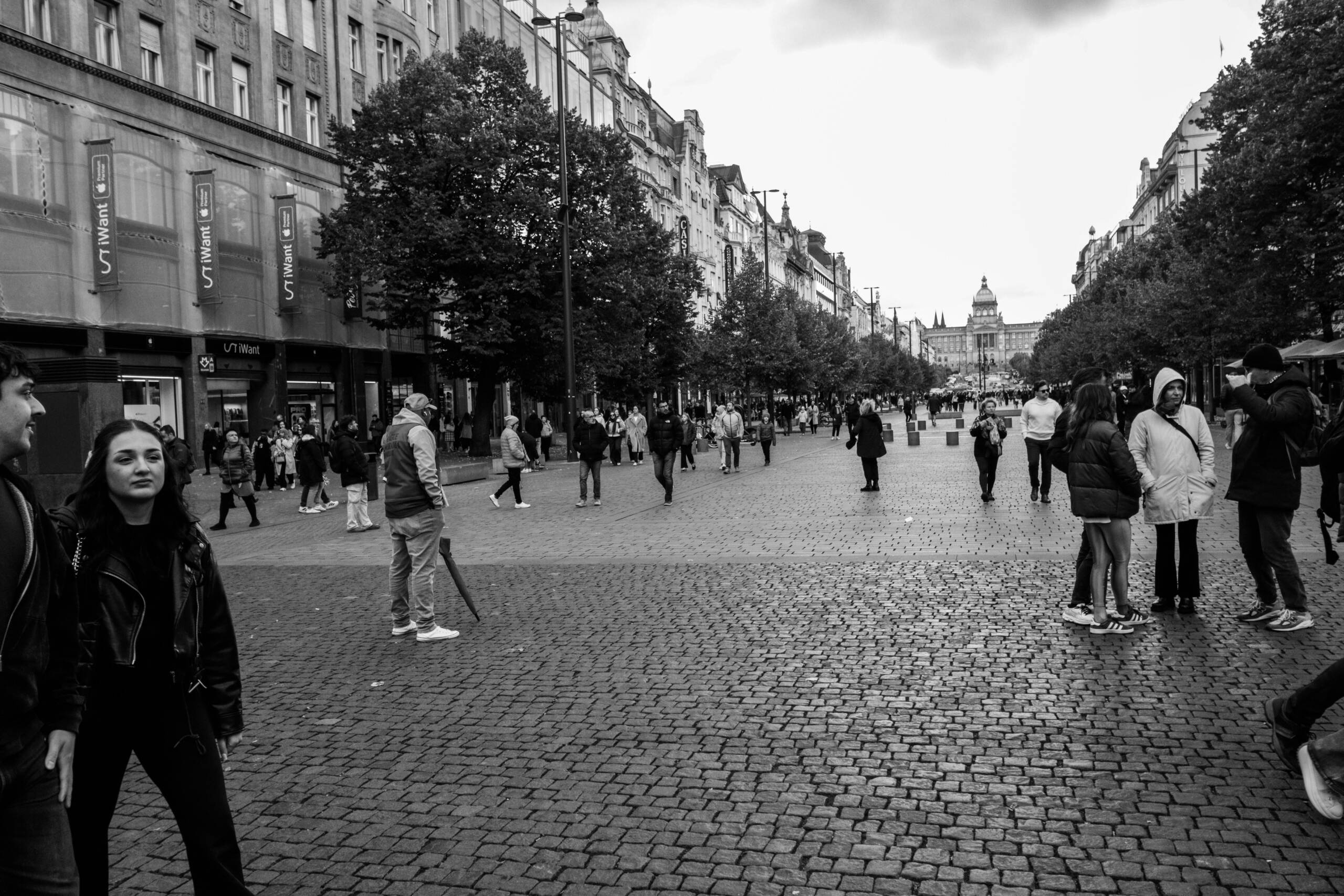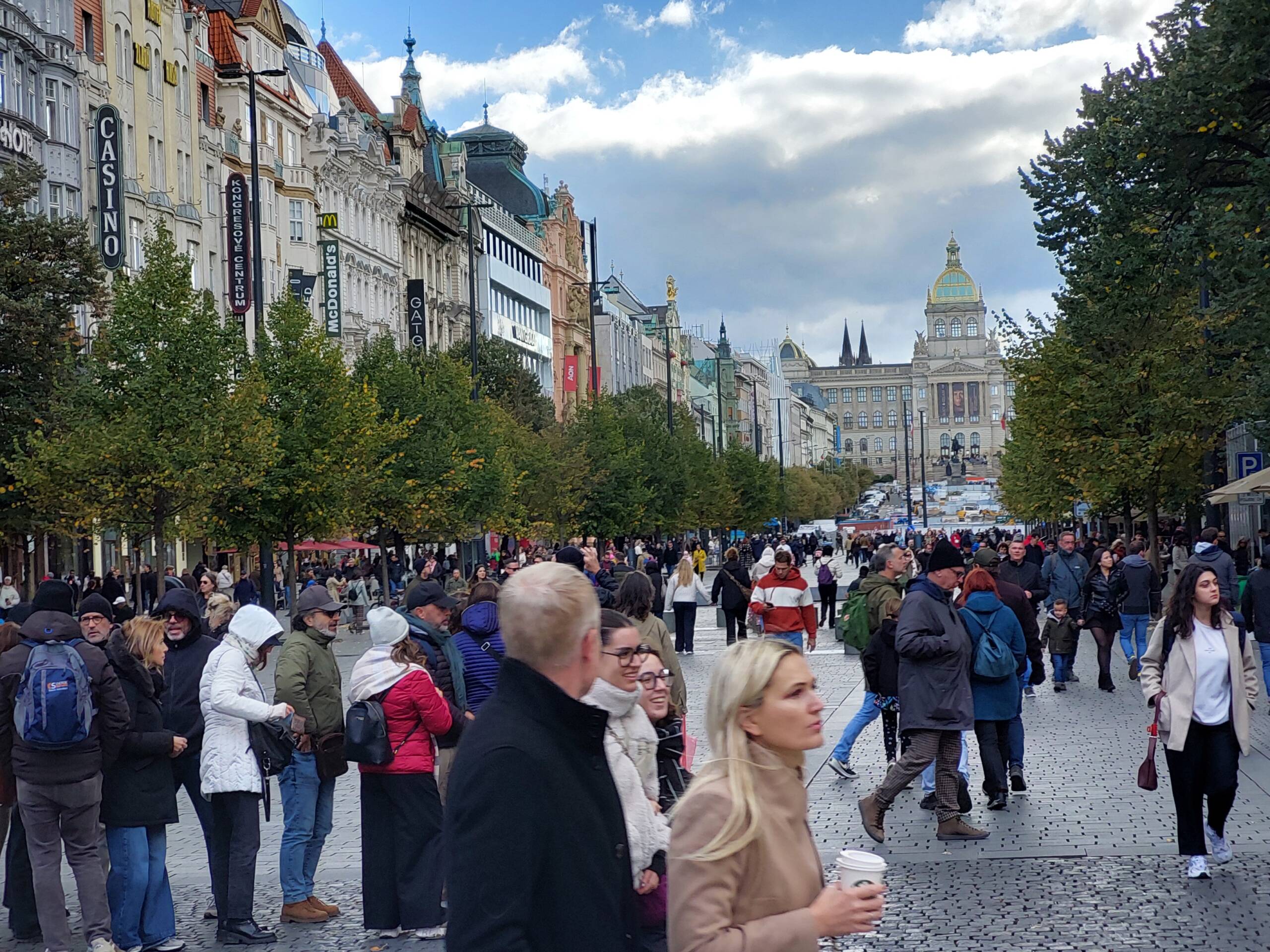When you stand in the middle of Venceslas Square in Prague, the first thing you notice is its deceptive vastness. It is not really a square, not in the geometric sense. Instead, it is a sweeping boulevard that stretches out like an arrow toward the grand, neoclassical dome of the National Museum, anchoring the space at the top. But as you look down the cobblestones, the street doesn’t seem to end—it just keeps pulling your gaze forward, narrowing with perspective, the façades leaning closer as if whispering their secrets. That illusion of infinity is what makes Venceslas Square so peculiar: it is both a space you can cross in twenty minutes and an expanse that feels immeasurable, a corridor of memory that carries far more than the people strolling its length at any given moment.

In black-and-white, the square gains another dimension. The commercial billboards vanish into neutral tones, the colors of fast-fashion shops dissolve into greys, and suddenly what’s left is pure shape and atmosphere. You see the rhythm of trees lined along the boulevard, the play of shadows against old façades, and the endless carpet of cobblestones underfoot. Those cobblestones are not just stones—they are textured reminders of weight and footsteps, of the millions of lives that have crossed here with purposes as ordinary as buying groceries or as momentous as toppling regimes.
The history embedded in Venceslas Square is almost too much for one space to carry. It was here, in 1968, that Soviet tanks rolled in to crush the Prague Spring, cutting short a hopeful experiment in “socialism with a human face.” It was here again in 1989 that thousands gathered, jingling their keys in the air as a symbol of change, demanding freedom from communist rule in what would become the Velvet Revolution. Between those two moments were countless others: memorials, vigils, small acts of resistance, and fleeting joys that the official records never captured but that the square somehow remembers. When you stand there, you can almost hear the echoes—chants swallowed by the air, footsteps blending into the rumble of history.
But what fascinates me most is the way the square has adapted, without ever losing its identity. On any given afternoon now, you’ll find a mix of people: locals in practical jackets rushing to appointments, tourists gazing upward with phones held high, street performers strumming guitars, groups of teenagers laughing loudly in front of a storefront. The air is filled with ordinary chatter, the kind that makes it easy to forget this was once a stage for national destiny. And yet, the weight lingers. Even as you sip a coffee from a takeaway cup or glance into a shop window, you feel that you’re walking over a palimpsest, where the mundane is layered over something profound.

The square’s endlessness is not only spatial but temporal. It stretches through time, holding layers upon layers of meaning, and never seems to run out of capacity to absorb more. For one generation, it was a site of grief. For another, defiance. For today’s, perhaps just a place to hang out on a Saturday or to stage the next protest when the moment demands it. Public spaces like this are never static—they breathe with the city, change moods with the seasons, and wait for the people to fill them with purpose again.
Walking there, you realize Venceslas Square is like a long inhale. It gathers people, stories, and energy, then exhales them back into the fabric of Prague. The statues and façades stand as silent witnesses, the cobblestones act as record-keepers, and the museum at the top presides over it all like a judge who has seen it all before. And yet, for all that it has witnessed, the square does not feel tired. It feels restless, alive, as if it is already preparing for whatever the next chapter might bring.
That is perhaps why standing here gives you a sense of both awe and comfort. You are one of thousands—millions—who have crossed this space, yet your presence adds a fresh layer to its ongoing story. The square has seen a lot, yes, but it still has room for you. And that may be the truest meaning of its endlessness: no matter how much history it carries, it always remains open to more.
Leave a Reply